Fast Battery Capacity Estimation Method Based on State of Charge and IC Curve Peak Value
Abstract
1. Introduction
2. Lithium Battery Testing and Data Selection
2.1. Test Objects and Test Steps
- (1)
- Conduct a complete charge and discharge test on the battery at a rate of 0.1 C-rate (C), record the voltage data of each group of batteries, and conduct capacity calibration.
- (2)
- Let stand for 5 min.
- (3)
- Charge the battery pack at a constant current rate of 0.25 C until any single unit reaches the charging cutoff voltage of 3.65 V, let it stand for 1 h, and record the voltage of each single unit once/s during the charging process.
- (4)
- Discharge the battery pack at a constant current rate of 1 C until any single cell reaches the discharge cutoff voltage of 2.8 V, let it stand for 1 h, and record the voltage of each single cell once/s during the discharge process.
- (5)
- Repeat steps (2)–(4) until significant capacity attenuation occurs.
2.2. Test Data Selection
3. Analysis of Lithium Battery Capacity Increase
IC Curve of Lithium Battery
4. Analysis of SOC Inflection Point of Lithium Battery
4.1. Curve of SOC-V
4.2. Analysis of Voltage Curvature Change
4.3. The Choice and Significance of Inflection Point
5. Combined Analysis of IC Curve Peak Point and SOC-V Curve Curvature Inflection Point
6. Conclusions
Author Contributions
Funding
Data Availability Statement
Acknowledgments
Conflicts of Interest
References
- Hu, X.; Li, E.S.; Yang, Y. Advanced Machine Learning Approach for Lithium-Ion Battery State Estimation in Electric Vehicles. IEEE Trans. Transp. Electrif. 2016, 2, 140–149. [Google Scholar] [CrossRef]
- Zhao, L.; Wang, Z.; Ma, Z.; Li, Y. An On-line SOH estimation method for power battery under low sampling rate. J. Energy Storage 2024, 83, 110695. [Google Scholar] [CrossRef]
- Zhu, J.; Wang, Y.; Huang, Y.; Gopaluni, R.B.; Cao, Y.; Heere, M.; Mühlbauer, M.J.; Mereacre, L.; Dai, H.; Liu, X.; et al. Data-driven capacity estimation of commercial lithium-ion batteries from voltage relaxation. Nat. Commun. 2022, 13, 2261. [Google Scholar] [CrossRef] [PubMed]
- Li, C.; Yang, L.; Li, Q.; Zhang, Q.; Zhou, Z.; Meng, Y.; Zhao, X.; Wang, L.; Zhang, S.; Li, Y.; et al. SOH estimation method for lithium-ion batteries based on an improved equivalent circuit model via electrochemical impedance spectroscopy. J. Energy Storage 2024, 86, 111167. [Google Scholar] [CrossRef]
- Wang, J.; Liu, P.; Hicks-Garner, J.; Sherman, E.; Soukiazian, S.; Verbrugge, M.; Tataria, H.; Musser, J.; Finamore, P. Cycle-life model for graphite-LiFePO 4 cells. J. Power Sources 2010, 196, 3942–3948. [Google Scholar] [CrossRef]
- Ma, Y.; Wu, L.; Guan, Y.; Peng, Z. The capacity estimation and cycle life prediction of lithium-ion batteries using a new broad extreme learning machine approach. J. Power Sources 2020, 476, 228581. [Google Scholar] [CrossRef]
- Matthieu, D.; George, B.; David, A. Perspective on State-of-Health Determination in Lithium-Ion Batteries. J. Electrochem. Energy Convers. Storage 2020, 17, 044701. [Google Scholar]
- Wang, H.; Li, Y.F.; Zhang, Y. Bioinspired spiking spatiotemporal attention framework for lithium-ion batteries state-of-health estimation. Renew. Sustain. Energy Rev. 2023, 188, 113728. [Google Scholar] [CrossRef]
- Hu, X.; Li, S.; Peng, H. A comparative study of equivalent circuit models for Li-ion batteries. J. Power Sources 2011, 198, 359–367. [Google Scholar] [CrossRef]
- Chen, S.Z.; Liang, Z.; Yuan, H.; Yang, L.; Xu, F.; Fan, Y. A novel state of health estimation method for lithium-ion batteries based on constant-voltage charging partial data and convolutional neural network. Energy 2023, 283, 129103. [Google Scholar] [CrossRef]
- Qu, S.; Kang, Y.; Gu, P.; Zhang, C.; Duan, B. A Fast Online State of Health Estimation Method for Lithium-Ion Batteries Based on Incremental Capacity Analysis. Energies 2019, 12, 3333. [Google Scholar] [CrossRef]
- Sun, Q.; Cui, F.; Shi, M. Capacity estimation of lithium-ion battery with multi-task autoencoder and empirical mode decomposition. Measurement 2024, 236, 115146. [Google Scholar] [CrossRef]
- Matthieu, D.; David, A. Best practices for incremental capacity analysis. Front. Energy Res. 2022, 10, 3333. [Google Scholar]
- Piao, C.; Sun, R.; Chen, J.; Liu, M.; Wang, Z. A feature extraction approach for state-of-health estimation of lithium-ion battery. J. Energy Storage 2023, 73, 108871. [Google Scholar] [CrossRef]
- Yang, N.; Song, Z.; Hofmann, H.; Sun, J. Robust State of Health estimation of lithium-ion batteries using convolutional neural network and random forest. J. Energy Storage 2022, 48, 103857. [Google Scholar] [CrossRef]
- Lyu, Z.; Tang, Y.; Wu, Z.; Wu, L.; Qiang, X. Online state of health estimation for Li-ion batteries in EVs through a data-fusion-model method. J. Energy Storage 2024, 100, 113588. [Google Scholar] [CrossRef]
- Matthieu, D.; David, B. Analysis of Synthetic Voltage vs. Capacity Datasets for Big Data Li-ion Diagnosis and Prognosis. Energies 2021, 14, 2371. [Google Scholar] [CrossRef]
- Matthieu, D.; Arnaud, D.; Yann, B.L. Two-Point State-of-Charge Determination in Lithium-Ion Battery Packs. Meet. Abstr. 2015, MA2015-01, 698. [Google Scholar]
- Tran, N.; Khan, B.A.; Choi, W. State of Charge and State of Health Estimation of AGM VRLA Batteries by Employing a Dual Extended Kalman Filter and an ARX Model for Online Parameter Estimation. Energies 2017, 10, 137. [Google Scholar] [CrossRef]
- Jiang, B.; Dai, H.; Wei, X. Incremental capacity analysis based adaptive capacity estimation for lithium-ion battery considering charging condition. Appl. Energy 2020, 269, 115074. [Google Scholar] [CrossRef]
- Li, Q.; Lu, T.; Lai, C.; Li, J.; Pan, L.; Ma, C.; Zhu, Y.; Xie, J. Lithium-ion battery capacity estimation based on fragment charging data using deep residual shrinkage networks and uncertainty evaluation. Energy 2024, 290, 130208. [Google Scholar] [CrossRef]
- Zuo, H.; Liang, J.; Zhang, B.; Wei, K.; Zhu, H.; Tan, J. Intelligent estimation on state of health of lithium-ion power batteries based on failure feature extraction. Energy 2023, 282, 128794. [Google Scholar] [CrossRef]
- Zhang, X.; Huang, Y.; Zhang, Z.; Lin, H.; Zeng, Y.; Gao, M. A Hybrid Method for State-of-Charge Estimation for Lithium-Ion Batteries Using a Long Short-Term Memory Network Combined with Attention and a Kalman Filter. Energies 2022, 15, 6745. [Google Scholar] [CrossRef]
- Dai, H.; Lai, Y.; Huang, Y.; Yu, H.; Yang, Y.; Zhu, L. State-of-health estimation of lithium-ion batteries using multiple correlation analysis-based feature screening and optimizing echo state networks with the weighted mean of vectors. J. Power Sources 2024, 623, 235482. [Google Scholar] [CrossRef]
- Goldman, R. Curvature formulas for implicit curves and surfaces. Comput. Aided Geom. Des. 2005, 22, 632–658. [Google Scholar] [CrossRef]
- Li, X.; Fan, D.; Liu, X.; Xu, S.; Huang, B. State of health estimation for lithium-ion batteries based on improved bat algorithm optimization kernel extreme learning machine. J. Energy Storage 2024, 101, 113756. [Google Scholar] [CrossRef]
- Nakano, K.; Vögler, S.; Tanaka, K. Advancing state of health estimation for electric vehicles: Transformer-based approach leveraging real-world data. Adv. Appl. Energy 2024, 16, 100188. [Google Scholar] [CrossRef]
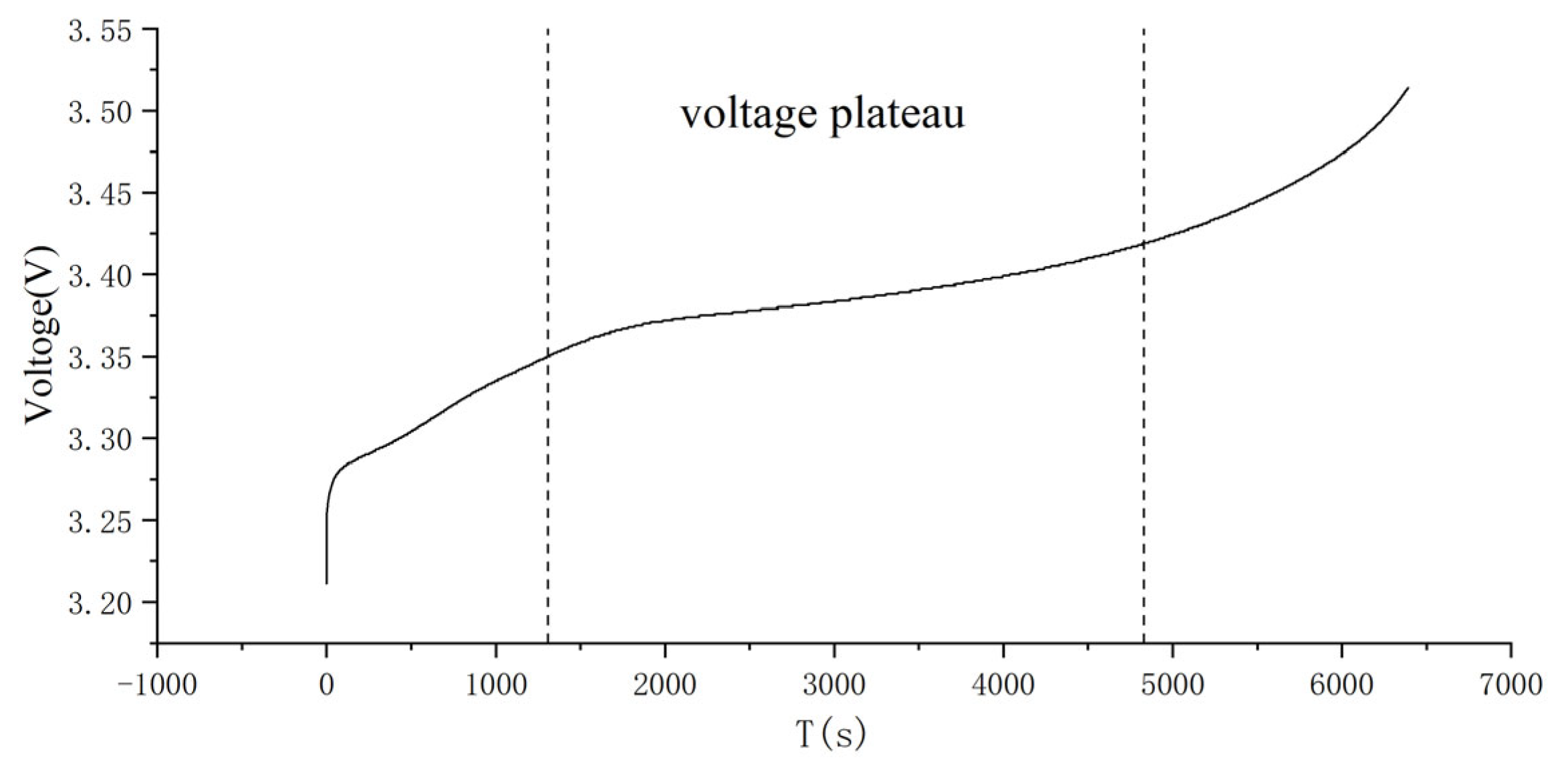

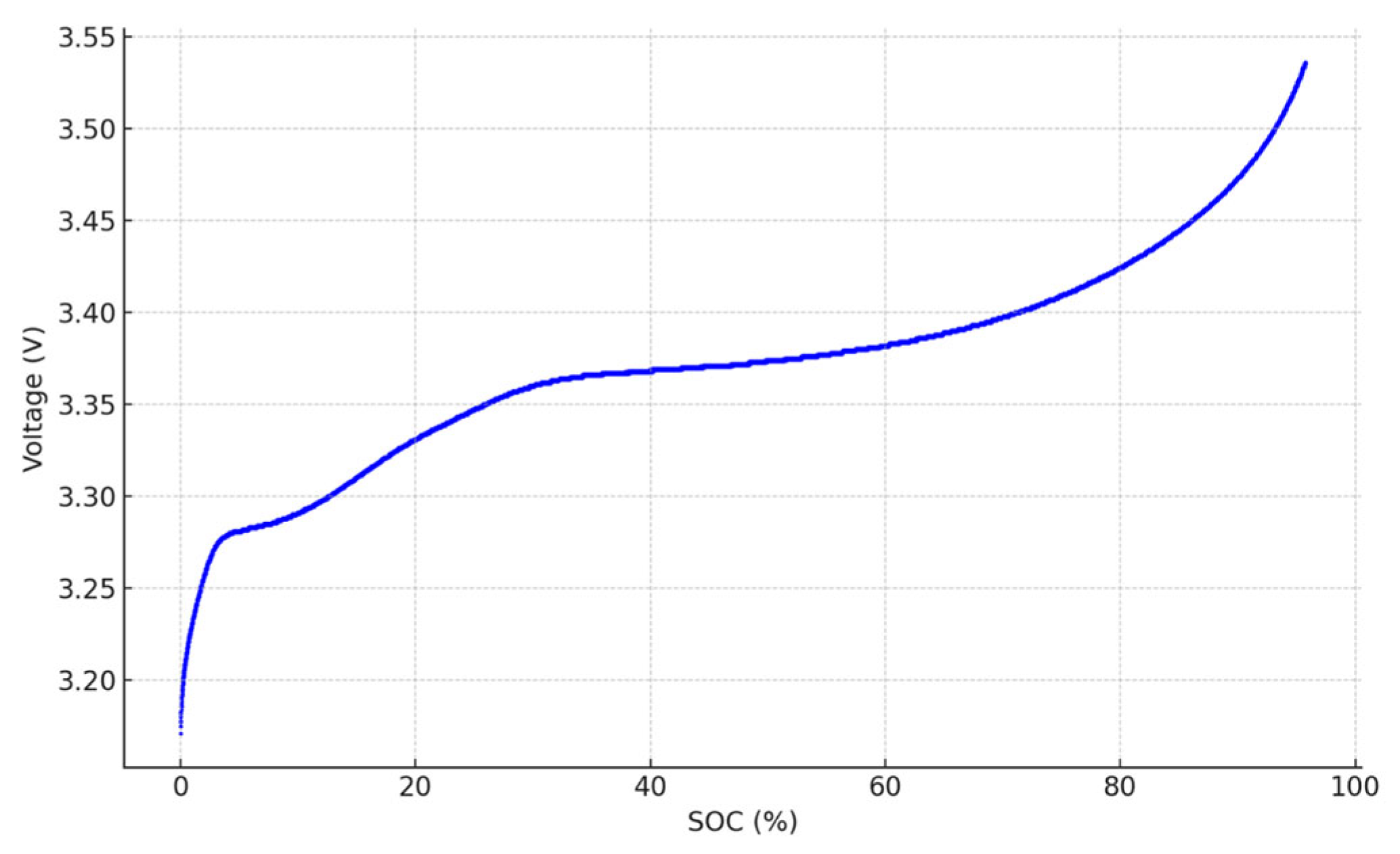

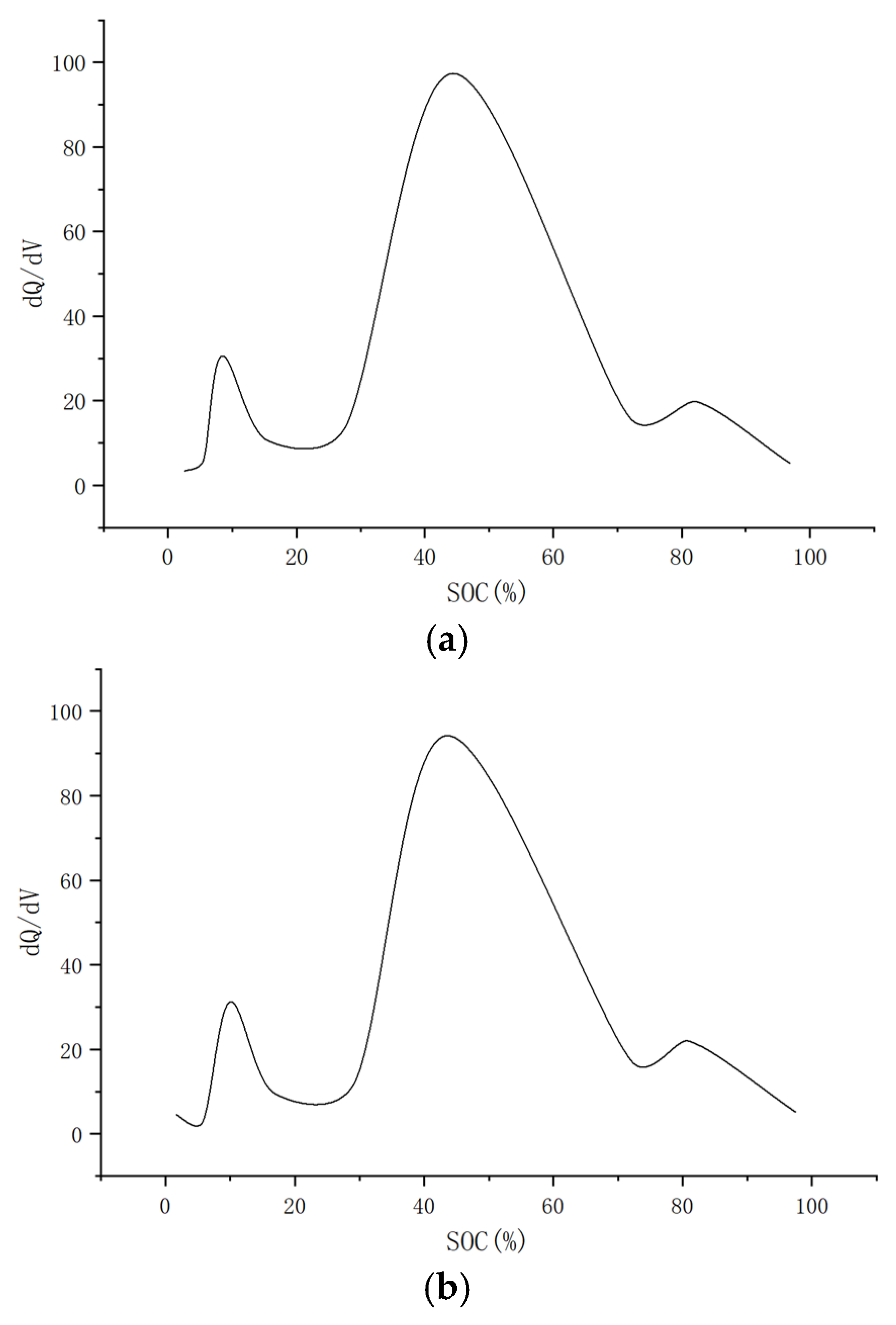
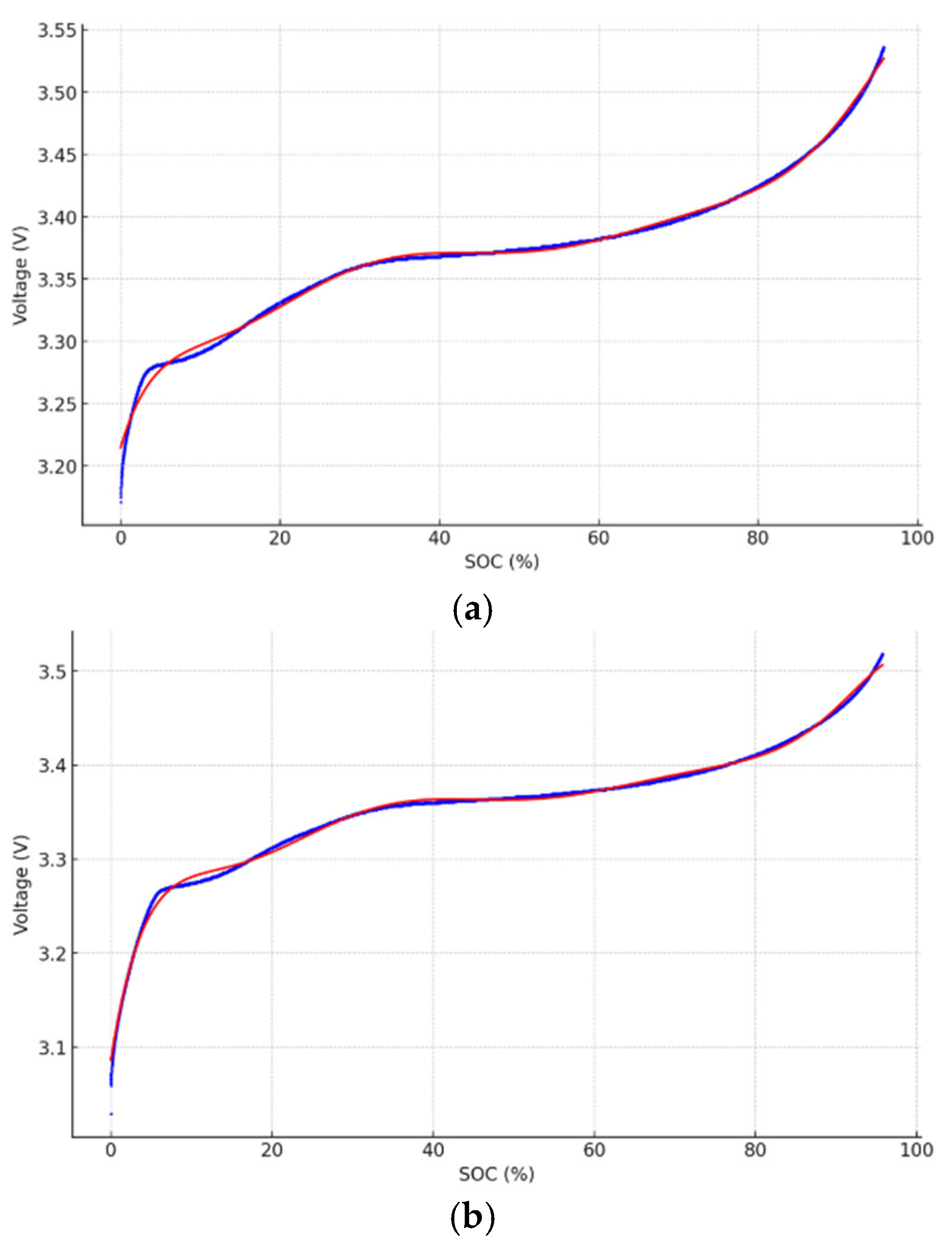
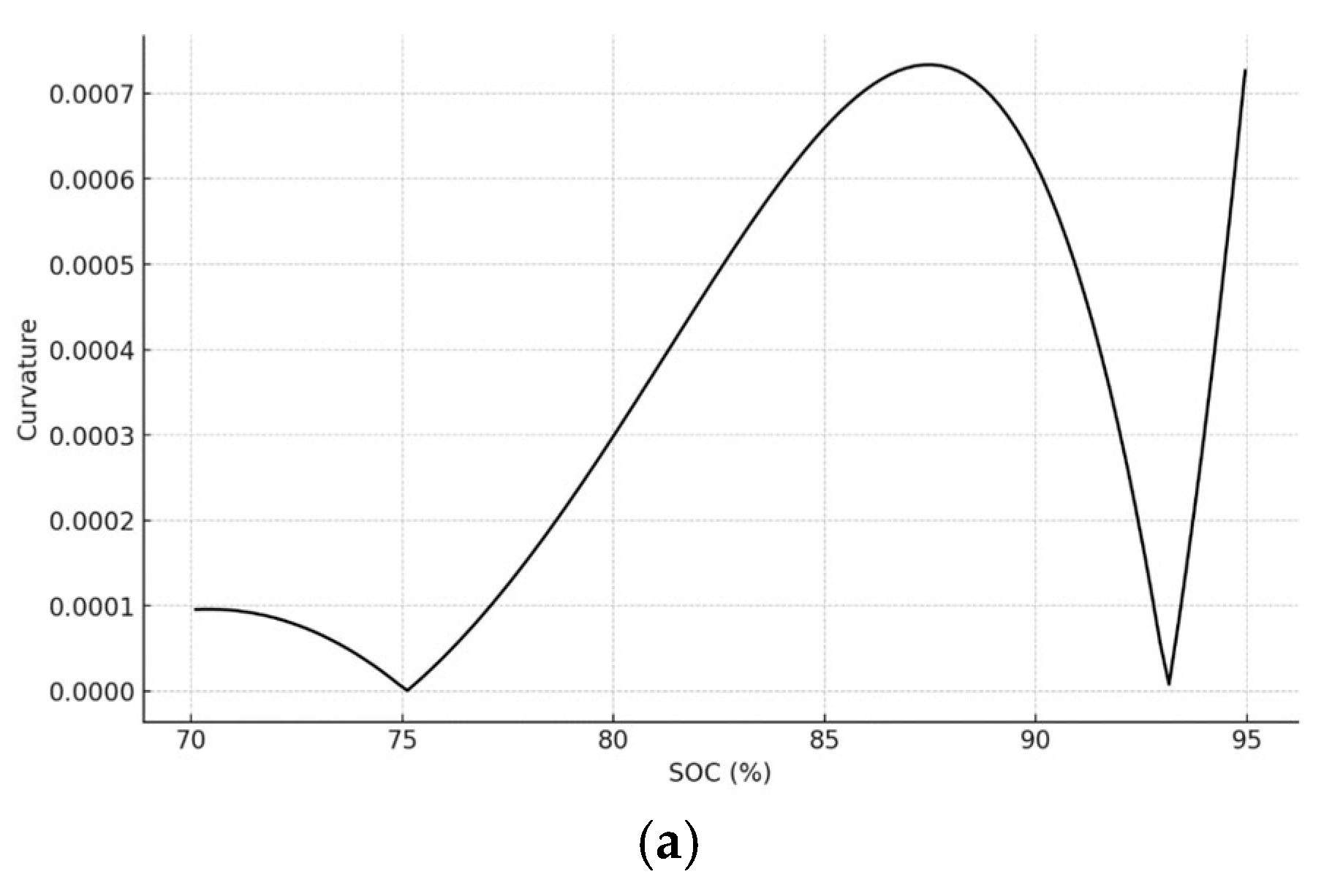
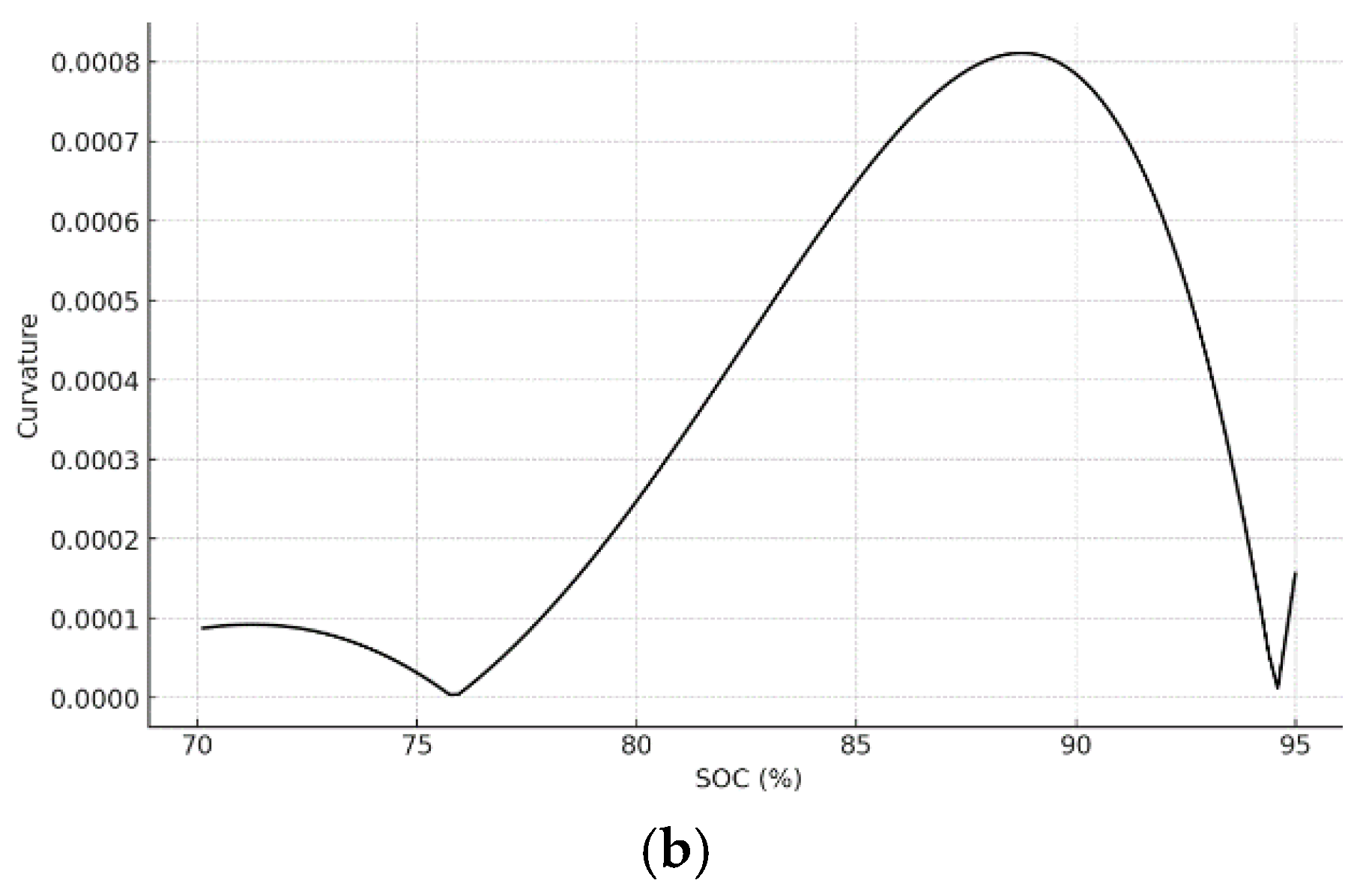


| SOH | Peak II SOC (%) | (%) |
|---|---|---|
| 92% | 54.62 | 94.52 |
| 85% | 55.34 | 95.15 |
| 75% | 54.74 | 94.97 |
| 65% | 55.49 | 95.42 |
| 55% | 55.02 | 95.11 |
| 45% | 56.86 | 96.56 |
| 35% | 54.44 | 95.01 |
Disclaimer/Publisher’s Note: The statements, opinions and data contained in all publications are solely those of the individual author(s) and contributor(s) and not of MDPI and/or the editor(s). MDPI and/or the editor(s) disclaim responsibility for any injury to people or property resulting from any ideas, methods, instructions or products referred to in the content. |
© 2025 by the authors. Published by MDPI on behalf of the World Electric Vehicle Association. Licensee MDPI, Basel, Switzerland. This article is an open access article distributed under the terms and conditions of the Creative Commons Attribution (CC BY) license (https://creativecommons.org/licenses/by/4.0/).
Share and Cite
Dai, Z.; Huang, B.; Liu, X.; Liu, D. Fast Battery Capacity Estimation Method Based on State of Charge and IC Curve Peak Value. World Electr. Veh. J. 2025, 16, 316. https://doi.org/10.3390/wevj16060316
Dai Z, Huang B, Liu X, Liu D. Fast Battery Capacity Estimation Method Based on State of Charge and IC Curve Peak Value. World Electric Vehicle Journal. 2025; 16(6):316. https://doi.org/10.3390/wevj16060316
Chicago/Turabian StyleDai, Zhenyang, Bixiong Huang, Xintian Liu, and Dong Liu. 2025. "Fast Battery Capacity Estimation Method Based on State of Charge and IC Curve Peak Value" World Electric Vehicle Journal 16, no. 6: 316. https://doi.org/10.3390/wevj16060316
APA StyleDai, Z., Huang, B., Liu, X., & Liu, D. (2025). Fast Battery Capacity Estimation Method Based on State of Charge and IC Curve Peak Value. World Electric Vehicle Journal, 16(6), 316. https://doi.org/10.3390/wevj16060316






